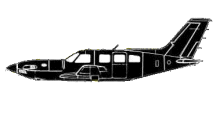
ASN Wikibase Occurrence # 290157
This information is added by users of ASN. Neither ASN nor the Flight Safety Foundation are responsible for the completeness or correctness of this information.
If you feel this information is incomplete or incorrect, you can submit corrected information.
| Date: | Wednesday 13 March 2013 |
| Time: | 09:40 LT |
| Type: |  Piper PA-46-500TP |
| Owner/operator: | N665kc LLC |
| Registration: | N665KC |
| MSN: | 4697265 |
| Year of manufacture: | 2006 |
| Total airframe hrs: | 725 hours |
| Engine model: | P&W Canada PT6A-42A |
| Fatalities: | Fatalities: 0 / Occupants: 3 |
| Aircraft damage: | Substantial |
| Category: | Accident |
| Location: | Brenham, Texas -
 United States of America United States of America
|
| Phase: | Approach |
| Nature: | Training |
| Departure airport: | Houston-West Houston Airport, TX (IWS/KIWS) |
| Brenham, TX (11R) | |
| Investigating agency: | NTSB |
| Confidence Rating: |
The flight instructor reported that the purpose of the flight was to practice engine failure procedures and power-off approaches. The accident occurred during the third approach of the flight as he was demonstrating the power-off approach technique. He noted that he had climbed to 3,500 feet, reduced engine power, and began a spiral over the airport to enter the left traffic pattern to the runway. During final approach, the airplane started descending at a higher rate. The flight instructor stated that he attempted to increase engine power but that he did not "hear or feel an indication of [engine] power increasing." The airplane subsequently impacted terrain about 165 feet short of the runway. Flight and engine data recovered from the avionics were consistent with a power-off approach. The engine gas generator speed, torque, interturbine temperature, and oil pressure parameters were stable at the end of the recorded data and were consistent to the same parameters recorded during the initial power-off approach. A postaccident examination of the airframe and engine did not reveal any anomalies consistent with an inability to obtain engine power. Functional testing and subsequent teardown examinations of the fuel pump, fuel control unit, and fuel oil heat exchanger also did not reveal any anomalies that would have precluded normal operation. Variations from standard production component settings were consistent with field adjustments.
Probable Cause: A lack of available engine power during an attempted go-around for reasons that could not be determined because the postaccident engine examinations did not reveal any anomalies consistent with an inability to produce rated power.
Accident investigation:
 |
|
Sources:
NTSB CEN13LA195
Location
Revision history:
| Date/time | Contributor | Updates |
|---|---|---|
| 06-Oct-2022 11:32 | ASN Update Bot | Added |
Corrections or additions? ... Edit this accident description
The Aviation Safety Network is an exclusive service provided by:


 ©2024 Flight Safety Foundation
©2024 Flight Safety Foundation